Key takeaways:
- Coalitions for change bring together diverse organizations to address complex issues like homelessness, combining unique strengths for effective solutions.
- Building authentic relationships and engaging stakeholders fosters trust and commitment, enhancing collaborative efforts and community impact.
- Flexibility in approach, along with a focus on listening and addressing concerns, can lead to innovative solutions and stronger coalition dynamics.
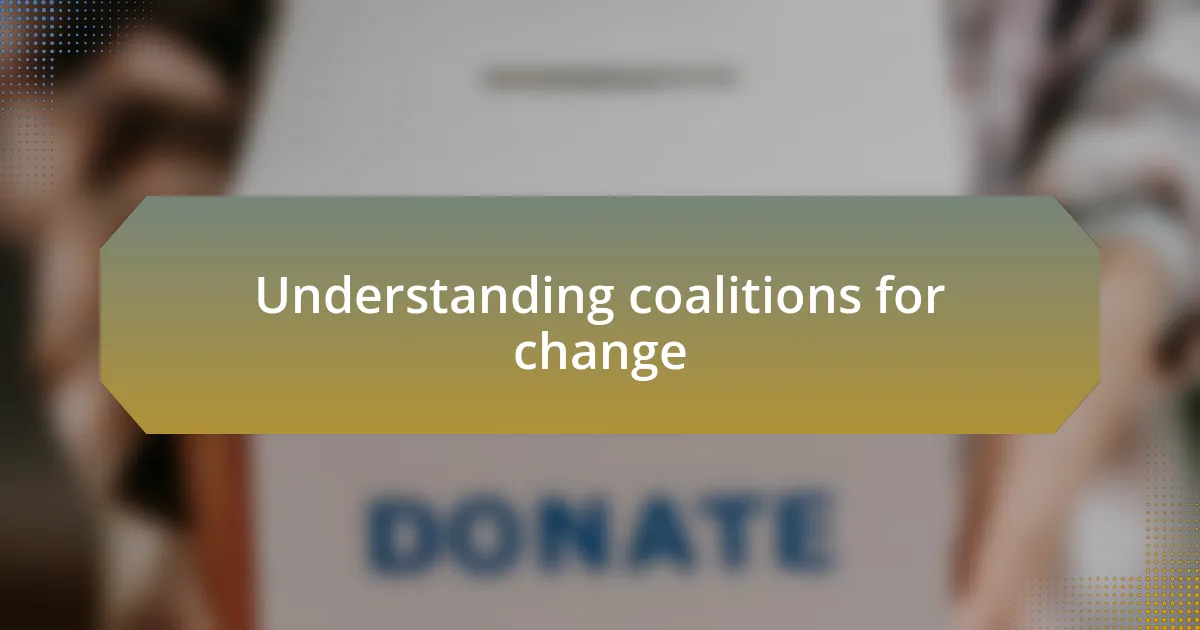
Understanding coalitions for change
Coalitions for change are essential in addressing complex social issues like homelessness. When I first began collaborating with diverse organizations, I realized that each partner brought unique strengths and perspectives to the table. Isn’t it fascinating how individuals with different experiences can unite for a common cause? This collective power is what fuels significant change.
One memorable moment for me was standing in a room filled with individuals from various backgrounds—nonprofits, local businesses, and even those who had experienced homelessness first-hand. Each voice contributed to a richer understanding of the problem, and I remember thinking how invaluable it was to have such varied insights. It’s a testament to the idea that when we connect and share our stories, we can craft solutions that are not only effective but also deeply compassionate.
Understanding coalitions also means recognizing the challenges they face. As I navigated these partnerships, I often wondered how to keep everyone engaged and motivated. Friction can arise when priorities differ, but I found that transparent communication and shared goals helped bridge those gaps. Have you ever experienced a moment of tension in a group project? Knowing that we all share a common mission can turn that tension into a drive for collective action.
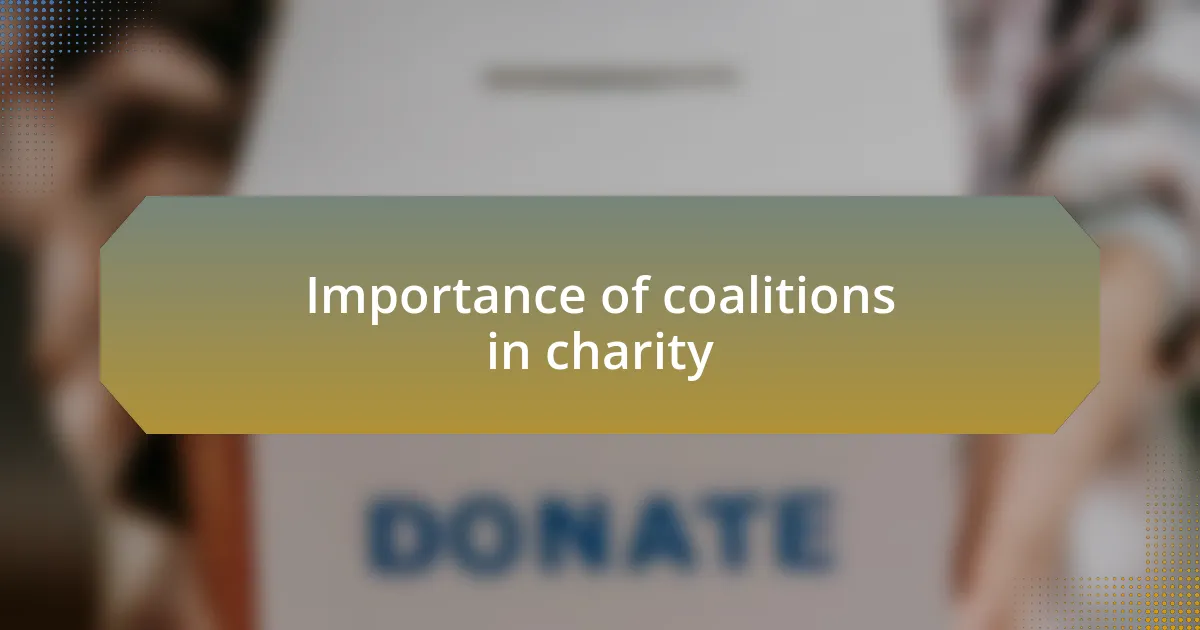
Importance of coalitions in charity
Coalitions play a crucial role in charity work, especially in addressing homelessness. I’ve often witnessed how pooling resources and expertise from various organizations can amplify our reach. When I collaborated with a local shelter and a housing advocacy group, we were able to provide comprehensive support to individuals that neither could have achieved alone. Isn’t it amazing what we can accomplish when we combine forces?
One experience that stood out for me was during a fundraising event, where multiple coalitions came together. The energy in the room was electric, not just because of the funds raised but because of the palpable sense of community. I remember speaking with a former resident of the shelter who shared how our collaborative efforts had given him hope and direction. It emphasized the idea that coalitions aren’t just about logistics; they’re about people. How often do we forget that behind every figure, there are real stories and struggles?
The importance of coalitions extends beyond immediate aid; they foster sustainable change by creating a network of support and accountability. I recall initiating discussions with partners who initially saw the issues from different angles. It was during those conversations that our varied expertise led to innovative solutions, like a program that combined job training with stable housing. This shared vision not only brought us closer but also ensured lasting impacts for the community we aimed to serve. Can you think of a time when coming together with others transformed a challenging situation for the better?
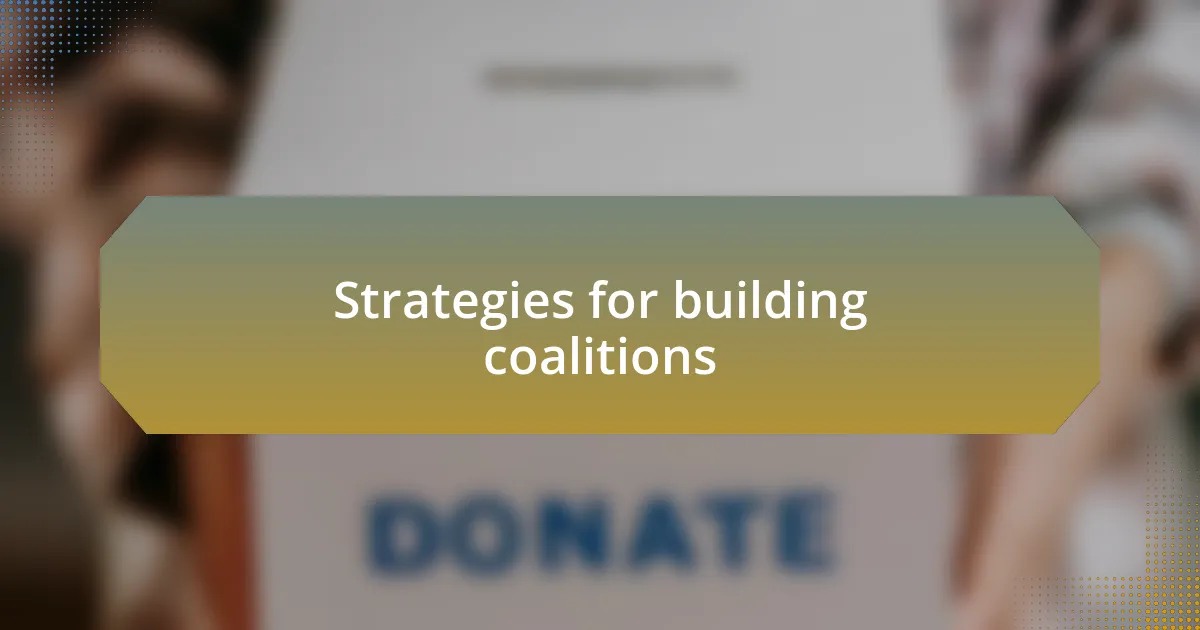
Strategies for building coalitions
Building coalitions starts with identifying common goals among potential partners. In my experience, I found that organizing informal meetings can create a comfortable environment for sharing visions and ideas. During one particular session I led, I was surprised by how openly colleagues from various sectors voiced their concerns about homelessness, ultimately aligning us toward a unified approach. Why do you think shared values are essential in initiating collaboration?
Effective communication is another cornerstone strategy. I remember a time when our coalition faced a potential setback due to misunderstandings. It was through regular check-ins and updates that we were able to clear the air and refocus on our objectives. This taught me that maintaining open lines of dialogue not only builds trust but also ensures that all members feel valued and heard. Isn’t it fascinating how a few candid conversations can transform the dynamics within a coalition?
Lastly, addressing power dynamics within coalitions can greatly enhance their effectiveness. In one partnership I facilitated, we paid close attention to ensure that all voices—especially those from marginalized communities—were amplified. By creating a space for equitable participation, everyone contributed unique insights that enriched our strategy. I believe that recognizing and respecting each partner’s strengths fosters a more inclusive environment. Have you ever noticed how collaborative efforts thrive when everyone feels empowered to share their perspectives?
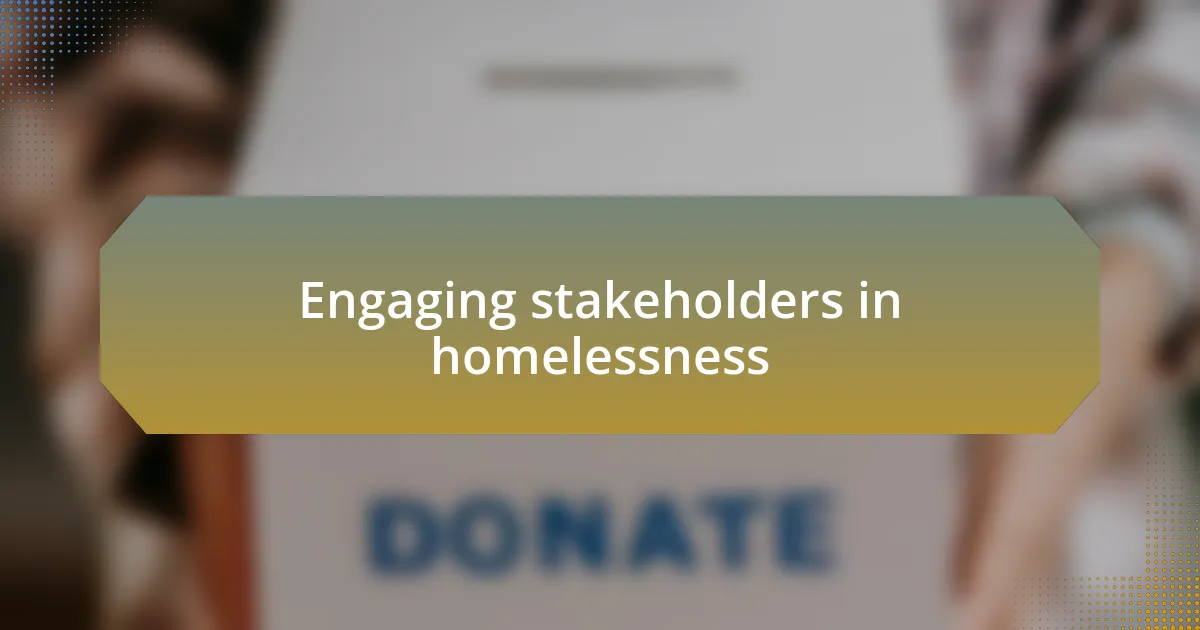
Engaging stakeholders in homelessness
Engaging stakeholders in homelessness requires careful consideration of their diverse backgrounds and interests. I once organized a community forum where everyone—from local business owners to service users—was invited. Witnessing the genuine exchange of ideas was eye-opening; I realized that each stakeholder had unique experiences that enriched our understanding of homelessness. Have you ever experienced such a moment where listening changed your perspective?
Building authentic relationships with stakeholders is another vital piece of the puzzle. I recall a particular incident where a local nonprofit felt sidelined in our conversations. By reaching out for coffee and actively listening to their concerns, I was able to rebuild trust and turn them into enthusiastic allies. This experience reinforced my belief that genuine engagement fosters a sense of belonging and commitment among partners. Have you ever thought about how a small act of outreach can lead to significant change?
Moreover, recognizing the emotional weight that the issue of homelessness carries for stakeholders often deepens the connection. During a roundtable discussion on homelessness, I saw tears in the eyes of a mother whose son had experienced homelessness. That moment encapsulated for everyone present why we were there—this issue isn’t just a statistic. It’s personal. I find that when stakeholders feel that emotional tie, their engagement grows stronger. How do you think personal stories could shift the focus in conversations around homelessness?
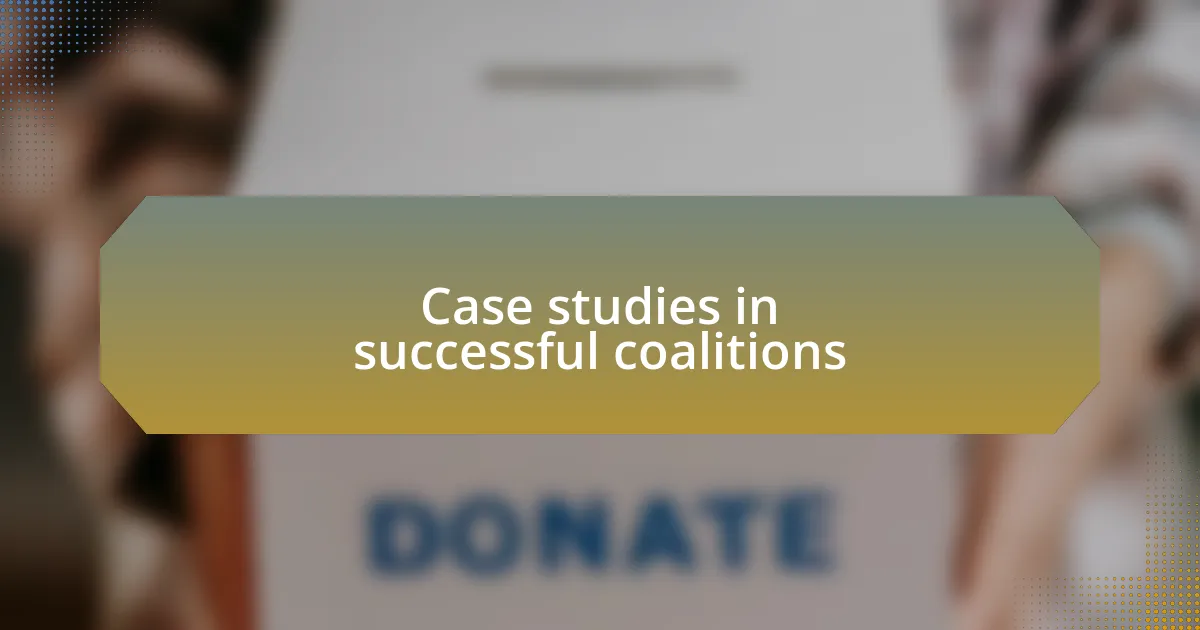
Case studies in successful coalitions
When I reflect on successful coalitions, one case stands out in my mind: a partnership I formed with a local health department and housing authority to address homelessness. By combining our resources, we developed a mobile health clinic that not only provided medical care to those in need but also connected them to housing options. Seeing clients who once felt abandoned receiving both healthcare and housing support was a transformative moment for all of us involved. Have you ever witnessed the power of collaboration in action?
Another striking example was a coalition I helped establish between shelters, food banks, and employment services. We organized a job fair specifically for homeless individuals, which brought together over 20 local businesses eager to hire. The air buzzed with hope as people who had been facing insurmountable barriers found opportunities to reclaim their lives. I still remember the smile of a young woman who got hired on the spot; it was a reminder of the difference a united front can make. How often do we underestimate the strength found in unity?
In a different coalition effort, I collaborated with faith-based organizations to launch a community-wide awareness campaign. We not only educated the public about homelessness but also created spaces for discussion. It was incredibly moving to witness individuals share their personal stories during events, highlighting the real faces behind the statistics. Each narrative was a testament to the need for compassion, and I felt a surge of energy in the room as connections were made. Can you recall a time where stories brought people together for a common cause?
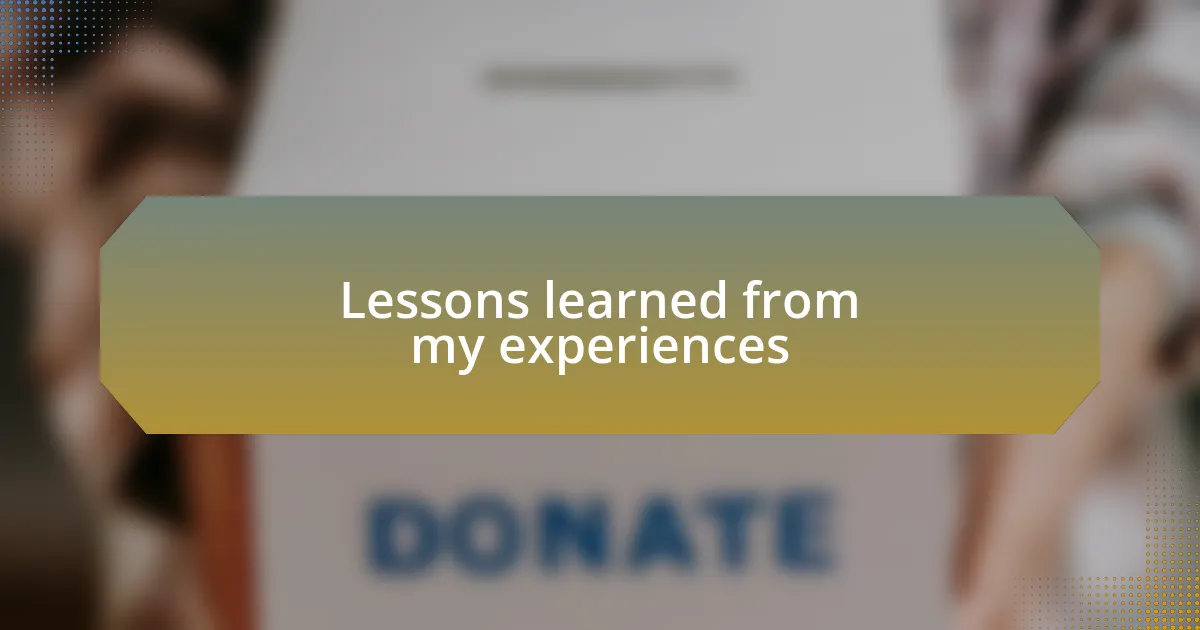
Lessons learned from my experiences
Building coalitions has taught me the sheer importance of listening. During one of our initial meetings with community stakeholders, I noticed how everyone brought unique perspectives to the table. At first, I was tempted to prioritize my own ideas, but I soon realized that the true strength of a coalition lies in amplifying each voice. Have you ever seen the difference it makes when people feel heard?
Another lesson I learned is that trust is essential in fostering collaboration. Early on, I had a coalition member express doubts about our goals, which caught me off guard. Instead of dismissing their concerns, I chose to address them head-on and ensure open communication. This not only built stronger relationships but also created an environment where everyone felt safe to share their honest opinions. Have you ever regretted not addressing an issue early on?
Finally, I discovered that flexibility can sometimes outweigh the initial plan. During one project, unforeseen challenges forced us to pivot our approach. Rather than seeing this as a setback, I embraced the change and encouraged my team to adapt. What happened next amazed me; we ended up uncovering new opportunities that had been hidden under our original framework. Isn’t it fascinating how obstacles can pave the way for innovation?